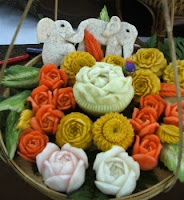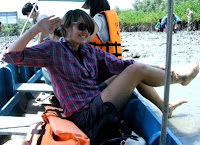Sowat-dee Kha!
Wow! The last time I posted was three months ago and I’ll probably need a cold Cambodian ice coffee with buckets of condense milk to energize me for what is to follow. Over the past three months, I have been constantly working, traveling, spending time with family, and unfortunately sick. On top of that, my To-Do List for the next couple of months I am here is overloaded. But, I would not be fair to myself if I do not keep up with my blog. I am going to try and recite everything from March over the next couple of weeks.
In March was the 3rd Mid-Year Enrichment Southeast Asia Fulbright Conference. It was held in Bangkok Cambodia
 |
| National Museum in Bangkok |
I was not able to attend every single presentation because they were scheduled alongside each other, but I will say that my favorite presentation was from Dr. Colleen O’Neal from Malaysia on the mental health of child refugees in Malaysia Burma Cambodia
 |
| Really concentrating hard |
On top of hosting the conference, the Fulbright Thailand Commission certainly hosted an expensive and activity-filled conference. After the end of presentations, they held a Cultural Night at the National Museum, where we were able to dress like the people in the nation that we are fulbrighting (yes, I made up this word) in and learn about Thai culture. The festival was a mix of a fair with games such as the ring toss, dart balloons, and shot gunning. It was such a classic moment to see these older Thai women holding up toy shot guns and aiming them at these little stuffed creatures.
 |
| Cooking Pad Thai! |
 |
| Carved elephant taro piece |
After, a bunch of us ventured out to see what the streets of Thailand Thailand
 The next day was also filled with adventure. The Fulbright Committee gave us two options of either visiting the
The next day was also filled with adventure. The Fulbright Committee gave us two options of either visiting the  bananas and planted some baby mangrove trees. It was quite an experience wearing these thick, knee-high socks and walking into the mud, which felt like sinking into quicksand while these little creatures and mini crabs crawl as fast as they do not get squash by our feet. I planted a couple of trees and then ran as fast as I could back to wash myself and get into the boat. I found that stepping softly and quickly helped me not sink too much.
bananas and planted some baby mangrove trees. It was quite an experience wearing these thick, knee-high socks and walking into the mud, which felt like sinking into quicksand while these little creatures and mini crabs crawl as fast as they do not get squash by our feet. I planted a couple of trees and then ran as fast as I could back to wash myself and get into the boat. I found that stepping softly and quickly helped me not sink too much.  |
| Awesome Roomie, Lisa. |
We all cleaned ourselves and had lunch on the water in this wooden house on stills. I met some pretty cool people at lunch—a Fulbrighter and her husband from Vietnam , a Thai Fulbrigher who will be at Harvard this upcoming school year and of course, my awesome roommate from Laos Thailand
 |
| Deep Fried Fish with Sweet Chili Sauce. Yummy! |
After lunch, we went to another province to see how mangrove trees can be turned into charcoal production. I was a little confused about the day’s earlier activities of conserving mangroves and replanting them, but apparently, this was in another plantation where mangrove trees are abundant? Yeah. Okay. That logic seems perfectly sound. Lets all buy hummers in the States because people in Cambodia
We took what seemed like a long bus ride home and went out to explore what the food stalls had to offer us. My roommate from Laos Thai.
The lovely conference trip ended and I was busy back at work.
Up next…Vietnam
Thank you for reading.
XX




